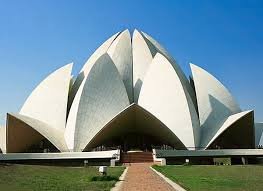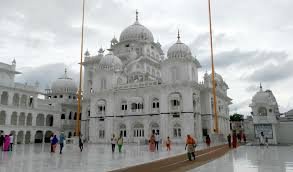Introduction
Nestled in the heart of Delhi, the Lotus Temple stands as a symbol of peace, unity, and architectural brilliance. Known for its stunning lotus-shaped design, this Bahá’í House of Worship welcomes people from all faiths, backgrounds, and cultures. Unlike many other temples, the Lotus Temple does not have traditional idols, rituals, or priests. Instead, it serves as a serene space for meditation, reflection, and spiritual enlightenment.
As one of Delhi’s most visited landmarks, the Lotus Temple attracts millions of tourists and devotees every year. Whether you seek inner peace, wish to admire its architectural grandeur, or simply want to experience its tranquil atmosphere, this temple offers something for everyone.
The Architectural Marvel of the Lotus Temple
The Lotus Temple is a true masterpiece of modern architecture. Designed by Iranian-Canadian architect Fariborz Sahba, the temple was completed in 1986 and has since been recognized as one of the most innovative structures in the world.
The temple’s design is inspired by the lotus flower, a sacred symbol in various religions, including Hinduism, Buddhism, and Jainism. It features 27 free-standing marble-clad petals, arranged in clusters of three to form nine sides. The entire structure is made of white marble sourced from Greece, which adds to its ethereal beauty.
Surrounding the temple, nine reflecting pools enhance its visual appeal while creating a peaceful ambiance. As sunlight reflects off the water and the marble petals, the temple glows magnificently, making it a breathtaking sight during sunrise and sunset.
Spiritual Significance of the Lotus Temple
Unlike traditional temples, the Lotus Temple is open to people of all faiths. It follows the principles of the Bahá’í Faith, which emphasizes unity, peace, and the oneness of humanity. The temple does not have any religious icons or images, allowing visitors to engage in silent prayer and meditation without any distractions.
The Bahá’í Faith believes in the fundamental unity of all religions and promotes a message of love and brotherhood. The Lotus Temple embodies these ideals by welcoming everyone, regardless of their religion, nationality, or beliefs.
Experiencing Tranquility at the Lotus Temple
One of the most remarkable aspects of the Lotus Temple is its atmosphere of complete silence. As you step inside, you are greeted by an overwhelming sense of calm. The absence of chants, bells, or traditional rituals creates a peaceful environment where visitors can disconnect from the chaos of daily life and immerse themselves in spiritual contemplation.
Visitors are encouraged to sit in silence, meditate, or pray according to their own beliefs. Whether you follow Hinduism, Christianity, Islam, Buddhism, Jainism, or any other faith, the temple provides a sacred space where you can connect with the divine in your own way.
Lotus Temple: A Hub for Cultural and Social Initiatives
Beyond its religious significance, the Lotus Temple plays an important role in promoting social harmony and education. The Bahá’í community organizes various programs and activities that focus on:
- Interfaith dialogue – Encouraging discussions between people of different religious backgrounds.
- Youth and children’s education – Hosting moral and spiritual education programs for young minds.
- Social service initiatives – Engaging in charitable activities that support underprivileged communities.
By fostering a spirit of unity and compassion, the temple continues to inspire positive change in society.
Best Time to Visit the Lotus Temple
The Lotus Temple is open throughout the year, but the best time to visit is during the winter months (October to March) when the weather is pleasant. During this period, you can explore the temple and its surroundings comfortably without the scorching heat of Delhi’s summer.
For a truly mesmerizing experience, visit the temple during early morning or late evening when the sunlight enhances its beauty, and the atmosphere is more peaceful.
How to Reach the Lotus Temple
The Lotus Temple is conveniently located in South Delhi, making it easily accessible by various modes of transportation.
- The nearest metro station is Kalkaji Mandir (Violet Line), just a short walk from the temple.
- Several DTC buses operate to and from Nehru Place and Kalkaji, which are close to the temple.
- You can also hire a cab or drive your own vehicle, as parking facilities are available near the temple.
Entry Fee and Visiting Hours
- Entry Fee: Free for all visitors.
- Visiting Hours:
- Summer: 9:00 AM – 7:00 PM
- Winter: 9:00 AM – 5:30 PM
- Closed on: Mondays
Nearby Attractions to Explore
If you are visiting the Lotus Temple, there are several other famous landmarks in Delhi that you can explore nearby:
- ISKCON Temple (Hare Krishna Temple): Located just 2 km away, this temple is dedicated to Lord Krishna and offers a vibrant spiritual experience.
- Kalkaji Mandir: A revered Hindu temple dedicated to Goddess Kali, just a short distance from the Lotus Temple.
- Humayun’s Tomb: A stunning Mughal-era tomb and UNESCO World Heritage site, located around 6 km away.
- India Gate: A historic war memorial, about 10 km from the temple, perfect for an evening stroll.
Why You Should Visit the Lotus Temple
The Lotus Temple is not just a place of worship—it is a sanctuary of peace, a masterpiece of architecture, and a hub of spiritual harmony. Here are some reasons why it should be on your travel list:
- Architectural Beauty: The lotus-shaped design and stunning marble construction make it one of the most remarkable structures in the world.
- Spiritual Experience: A perfect place for meditation, self-reflection, and inner peace.
- Inclusive Atmosphere: Welcomes people from all faiths, promoting unity and harmony.
- Free Entry: Unlike many attractions, the temple does not charge an entry fee, making it accessible to all.
- Cultural and Social Initiatives: The temple plays an active role in fostering education, dialogue, and humanitarian efforts.
Conclusion
The Lotus Temple stands as a beacon of peace, spirituality, and architectural brilliance in the bustling city of Delhi. Whether you are a devotee, a traveler, or someone seeking a tranquil escape, this temple offers a unique and enriching experience. With its silent prayer hall, breathtaking design, and message of unity, the temple continues to inspire millions across the world.
If you are in Delhi, make sure to visit the Lotus Temple and immerse yourself in its serene and divine ambiance. It is an experience that will leave you with a sense of peace, enlightenment, and a deeper appreciation for humanity’s shared spiritual heritage.





